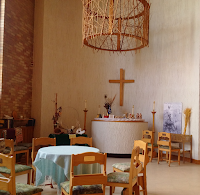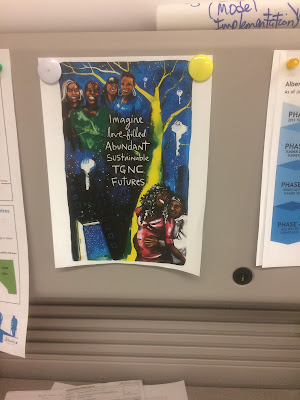This site has extensive discussion of uncertain spaces and declared spaces. Much of it has focused on the big declaring that a church can do in terms of how welcoming and embracing it is. The outward signs, and the many inward ways which make the declaration more than just words and empty gestures.
One of the ways a church or organization can declare itself further, which has not been discussed here yet, is by having specific declared spaces within a broader declared space. As will be seen in the following examples, some of these specific spaces are physical spaces; others are "spaces in time". As well, there are also ways for people within a church or organization to declare themselves...
declared "spaces in time" within declared spaces
These are defined declared spaces that happen at certain times, within a broader declared space. Here are some examples.
example 1: standing stones services
Several churches in our parish hold Standing Stones services once a month, in some cases during the regular Sunday morning service time.
"Standing Stones is a gathering of Aboriginal and Non-aboriginal People to explore God in an Aboriginal Context. We come to worship Jesus, infusing Cree symbols into Christian ceremony. We smudge to purify our minds, hearts and spirits in order to come to a clearer understanding of God; we seek wisdom in Aboriginal story and scripture, we ask for God’s healing water and prayer on ourselves and our community and we celebrate God’s activities in our lives though the sharing of bannock and berries. Standing Stones is a fresh expression of Jesus to the Aboriginal Community and to the diocese. The hope is that this gathering is a means of Christ’s reconciling Love to heal ancient wounds and enlighten the next generation of all Canadians."(source)
example 2: equally anglican services
You might wonder why a church which is openly affirming of lgbtq+ people would have an additional specific service of this type.There are in fact several reasons. First, the service is a declared space and is one way that the church expresses it is a declared space overall. It says "we're serious about affirming people." Imagine a church that claimed it was welcoming of single mothers, yet single mothers were never mentioned and nothing whatsoever about the church reflected that...
Secondly, the service is an opportunity for non-parishioners to be involved, including those who have their own regular church commitment on Sunday mornings yet want to participate in an lgbtq affirming service.
Both of these are ways in which a church can more actively declare itself as embracing of people.
physical declared spaces within declared spaces
These are physical spaces -- within declared larger spaces/institutions -- which declare themselves specifically.
A friend of mine has been a youth pastor in conservative churches for many years. Recently, he changed churches and is working for a denomination known for being affirming of lgbtq+ people.
He posted a picture of their newly decorated youth room along with this comment:
If he as youth pastor has been concerned about churches pushing out lgbtq+ youth, how much more are youth in our churches concerned about this? Youth in general are sensitive to this, and for lgbtq+ youth (and adults) in our churches, making a clear statement is critical for their spiritual well-being."Just finished redecorating our youth room. So happy to be in a church that supports building inclusive spaces for youth. In the last year 3 youth have come out as gay or bi and 1 as Trans and for the first time in my 20+ years working with youth I am not afraid they are going to be pushed out of the church."
example 4: indigenous chapel inside Anglican cathedral
The chapel is replete with indigenous symbols and artefacts and, while not a full circle, is designed in a more circular way. It is located in the mezzanine, which is more amenable to such an arrangement than the main nave.
How might such a space make it easier for indigenous participants to feel part of the service?
example 5: sacred spaces at public institutions
Along with churches, other institutions such as universities and hospitals are also creating specific declared spaces. The Faculty of Arts at the University of Alberta has opened an aboriginal gathering space.
"Lori Myers, Aboriginal student adviser, said a dedicated space such as this can be transformational, especially given that the 171 self-identified Aboriginal students are spread throughout a large and diverse faculty." (source)St. Paul's Hospital in Vancouver has created an All-Nations Sacred Space. St. Paul's Hospital in Saskatoon, along with the chapel and a multi-faith "stillness room", has a First Nations Prayer and Ceremonial Room.
Historically, many hospitals had chapels, especially Catholic hospitals. Over time, the chapels which were typically Catholic or Protestant evolved into multi-faith chapels, designed to work for clergy and adherents of many different faiths. However, that does not mean they work for indigenous peoples that in terms of physical structure, symbols, etc. So this "trend" to have sacred spaces is an important way of welcoming and embracing our indigenous brothers and sisters.
 positive declared spaces within hostile declared spaces
positive declared spaces within hostile declared spacesDeclared spaces can either be positive or negative, welcoming or hostile. Sometimes, in the midst of hostile declared spaces, people make positive spaces. Here are some examples:
example 6: LGBTQ groups at conservative christian colleges
OneWheaton is an LGBTQ+ group at Wheaton College, a conservative Evangelical college in Illinois. Here's how they describe themselves:
example 7: outlier priests in a parish
Just as there can be liberal parishes with a conservative priest or two, so can there be more conservative parishes with a priest or two who is welcoming and affirming and who work to move
their parish toward being welcoming and affirming, regardless of what the diocese says.OneWheaton is an LGBTQ+ group at Wheaton College, a conservative Evangelical college in Illinois. Here's how they describe themselves:
OneWheaton’s mission is to be an open, inclusive, and safe community for LGBTQ and Allied alumni and students of Wheaton College (IL). We support students and alumni with compassion, counsel, and resources so that they can live full, vibrant lives. We affirm LGBTQ individuals and the relationships that are a natural expression of their identity. (source)There are similar groups connected with other conservative educational institutions. OneWheaton has a list of such movements.
example 7: outlier priests in a parish
Just as there can be liberal parishes with a conservative priest or two, so can there be more conservative parishes with a priest or two who is welcoming and affirming and who work to move
declared people
Declared spaces can have declared physical spaces and declared "spaces in time" that reinforce their declaredness. But it is also possible for individuals within those spaces to declare themselves, to clearly articulated if and how they value and embrace diverse people.
For example, many companies and, of course, the governments here in Canada, have clear policies and statements about diversity, equal opportunity, non-discrimination, etc. They might also have posters and communications about this. But the person who is part of a sexual or gender minority, high level policies and posters at the water cooler do not tell them anything about how colleagues will respond to them if they talk about their personal lives or weekend activities in the same manner and openness that their cisgendered straight colleagues would. Equally, for someone of a racial or ethnic minority, official policies do not ensure acceptance and equality.
How can an individual make such a space -- an office space, in this case -- a declared space? How can an individual let colleagues know that it's alright for them to be as open as they wish, without being awkward or too forward about it? How can someone who is part of the majority communicate an embrace of others?
Here are some simple examples:
example 8: clothes and jewelry
 Wearing a specific piece of jewelry or a printed T is another way of signalling a declared space. Jewelry could range from the typical silicone "cause"-type of bracelet to more fashionable beaded bracelets, to small pins or pendants.
Wearing a specific piece of jewelry or a printed T is another way of signalling a declared space. Jewelry could range from the typical silicone "cause"-type of bracelet to more fashionable beaded bracelets, to small pins or pendants.Now, these days, wearing a cross around your neck doesn't mean anything about your religion. And even wearing indigenous art doesn't necessarily mean respect for indigenous communities, but it can be a signal of openness.
Some symbols are more likely to mean something. We attended a church for a while that had no obvious signs of being welcoming to lgbtq people. One Sunday, however, the retired priest who was filling in wore a small rainbow pin, a clear indicator that he is affirming of lgbtq+ people.
At a previous workplace, one of my colleagues wore a Love Wins t-shirt on Valentine's Day. Most people would simply see it as a Valentine's-related statement. Some would know that it is related to GLAAD and that he is accepting of lgbtq people.
Sometimes, there are specific days when one declares oneself in support of something. Take Pink Shirt Day, for example. It started when:
“David Shepherd, Travis Price and their teenage friends organized a high-school protest to wear pink in sympathy with a Grade 9 boy who was being bullied [for wearing a pink shirt]" (source)Now it's a national movement in Canada, held on February 28th, which raises awareness and money for anti-bullying initiatives. Similar days are held for other causes.
Of course, sometimes such days are officially recognized by a company or organization. When that is the case, it also becomes a "declared space in time". For example, the organization I currently work for recognizes Pink Shirt Day and National Aboriginal Day. The company I worked for previously, recognized International Women's Day. Now, does this mean that everyone in the company is on board and treats women equitably? No. But it does provide the company an opportunity to declare itself regarding equality of women and, perhaps more importantly, gives an opportunity for interested employees to declare themselves by their involvement in the day's optional celebrations.
example 9: personal items at the office or worksite
Many people have personal items in their cubicle or office. These range from family photos and postcards, to personal mugs, to plants and books. It can be an easy and appropriate way to communicate values and perspectives. Attended an interesting event recently? Put up one of their promo handouts.
Here's a poster that I came across via Facebook, and which I printed and put up in my cubicle:
I like it for a lot of reasons:
- It's a great design - I love the colours and the layout
- It's positive - talks about imagining love-filled abundant futures
- It portrays black people as main characters instead of sidekicks in a white world
- It makes reference to a minority without being highly obvious about it -- "TGNC" stands for Transgender Non Conforming. To someone not paying much attention, it is passed over. To someone who is transgender, they might well know.
- It's appropriately sized -- the same as the rest of the pages posted in my cubicle
- And it's a simple way of communicating openness and diversity, while making my cubicle a bit more human than all the charts and diagrams!
example 10: formally declared people
Some companies and government agencies have Positive Space programs, and these usually include "positive space champions. These are employees who have volunteered to "offer support, raise awareness, and wear and post identifiers to designate both themselves and their workspaces as safe." There will be another post especially about the Positive Space program.
conclusion
This article has looked at some examples of smaller declared spaces within declared spaces, whether these are physical spaces, "spaces in time", or people functioning as declared points. And of course, it is also possible to have a declared positive space inside of a space that is uncertain or even in fact hostile. Declaring oneself in terms of valuing and embracing diverse people is never a matter of coming up with a nice sounding statement. It has to be part of the culture of a church or organization, and reflected at many levels.
rob goetze









No comments:
Post a Comment